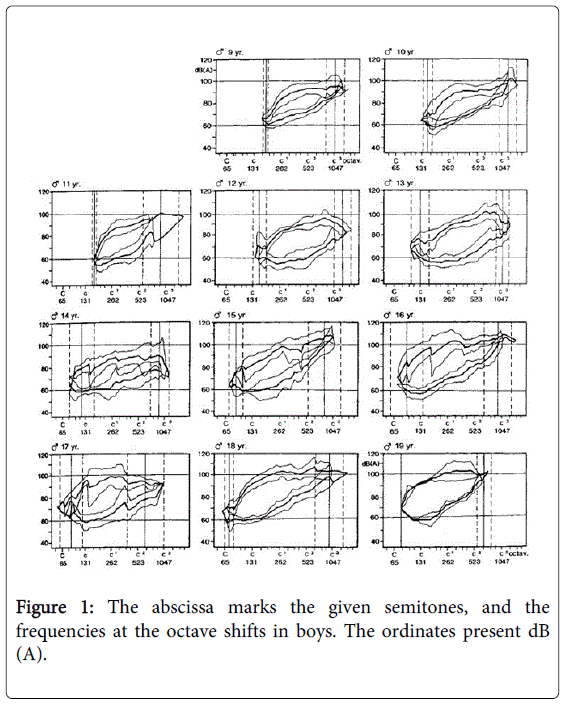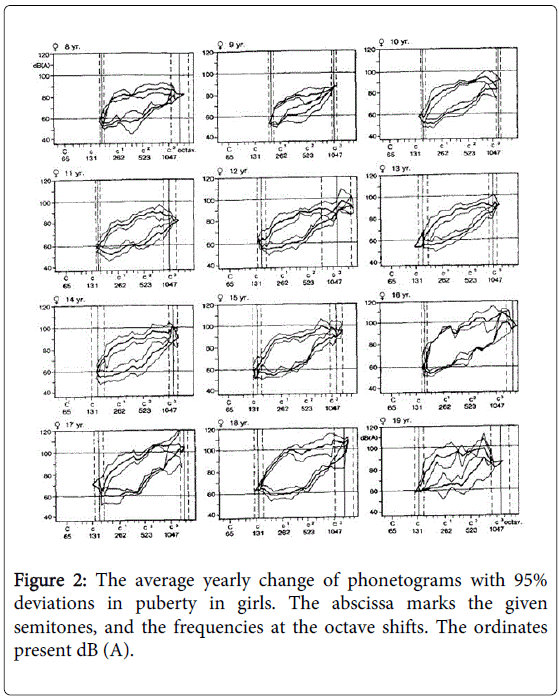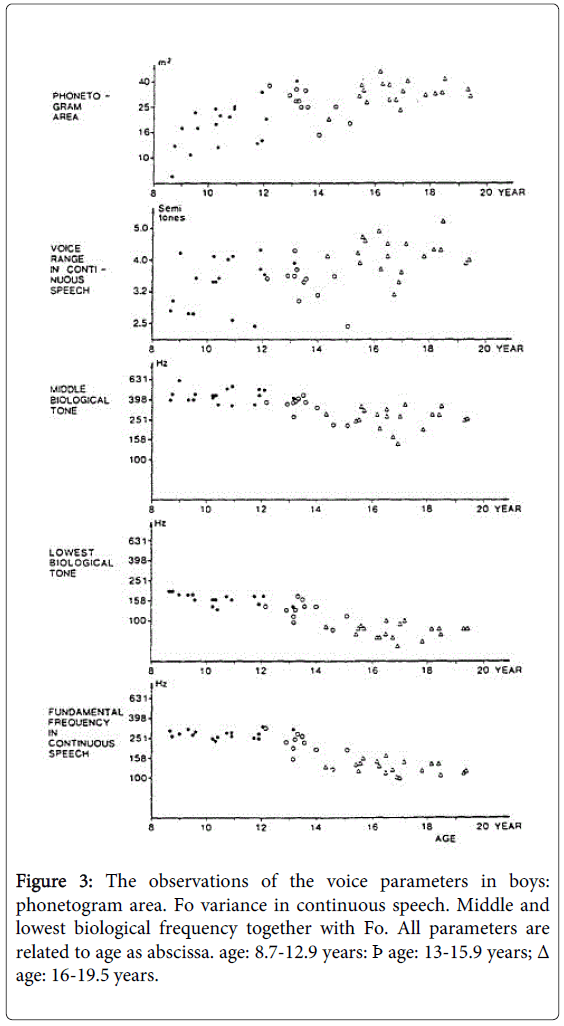Review Article Open Access
Aspects of Adolescence and Voice: Girls versus Boys – A Review
Mette Pedersen*, Anne B Alexius Agersted and Anders Jønsson
Department of Medicine, Voice Unit, Østergade 18, 3, 1100 Copenhagen, Denmark
- *Corresponding Author:
- Mette Pedersen
Department of Medicine,Voice Unit
Østergade 18, 3, 1100 Copenhagen
Denmark
Tel: +4531126184
E-mail: m.f.pedersen@dadlnet.dk
Received Date: February 23, 2015; Accepted Date: June 08, 2015; Published Date: June 13, 2015
Citation: Pedersen M, Agersted ABA, Jønsson A (2015) Aspects of Adolescence and Voice: Girls versus Boys – A Review. J Child Adolesc Behav 3:211. doi:10.4172/2375-4494.1000211
Copyright: © 2015 Pedersen M et al. This is an open-access article distributed under the terms of the Creative Commons Attribution License, which permits unrestricted use, distribution, and reproduction in any medium, provided the original author and source are credited.
Visit for more related articles at Journal of Child and Adolescent Behavior
Abstract
A survey has been given of the development of voice in adolescents. The voice parameters fundamental frequency during reading of a standard text and phonetograms where compared with the pubertal development and the androgens and estrogens in boys and girls respectively. The review of adolescent voice development in girls and boys briefly present the core results of the study “Normal Development of Voice in Children: Advances in EvidenceBased Standards“. It shows that not only boys but also girls’ voice change during puberty.
Keywords
Voice development; Voice frequency; Phonetogram; Hormonal changes
Abbreviations and Definitions:
DHEAS: Dihydroepiandrosterone Sulphate; EGG: Electroglottography; El: Estrone; E2: Estradiol; E1S04: Estrone Sulphate; F0: Mean Fundamental Frequency in Running Speech in A Reading Situation Of A Standard Text; F0: Range Frequency Variation In Semitones in Running Speech in A Reading Situation of A Standard Text (= Voice Range); LTAS: Long Term Averaged Spectrogram; Octaves: German Discription: C-C-C L-C2-C3, American: C3 = C, C4 = C, C5 = C2 etc.; SHBG: Sex Hormone Binding Globulin; ST: Semitone in the Octave, Defined from the Phonetogram; SPL: Sound Pressure Level; Total Pitch Range: The Range from the Lowest to the Highest Semitone in the Phonetogram
Introduction
The study was made because there is a huge need among choir leaders and singing teachers to differentiate between development of voice and pathology. Vocal quality and speech develop essentially in childhood and adolescence of boys and girls. The understanding of how the pediatric voice develops and changes over time is crucial for the evaluation of children with voice disorders and their response to treatment. In children choirs the measurements support the singing teachers in differentiating between development of voice and pathology (e.g. allergy and infections). This review is based on the study of Mette Pedersen from 2008 “Normal Development of Voice in Children: Advances in Evidence-Based Standards“.
Frequency of the speaking voice
The fundamental frequency of voice changes with age from childhood through puberty to adulthood related to the hormonal development. The frequency of the normal speaking voice in children ranges from 250-400 Hz, adult females tend to speak around 200 Hz on average, and adult males around 150 Hz [1].
The fundamental frequency of the speaking voice for girls changes from 256 Hz in the pre-pubertal group to 241 Hz in the post-pubertal group. The tonal range of the speaking voice increases from its prepubertal value of 3.7 semitones (ST) to a post-pubertal value of 5.2 ST; these changes are significant to 99% [2]. The changes of register in singing for boys, measured with EGG, was 627 Hz in group 1 (age 11.8-13.2 years; testosterone<1 nmol) and around 649 Hz in group 2 (age 13.2-14.7 years; testosterone<10 nmol). In group 3 (age 14.8-16.9 years) the change of register had fallen with a significance of 99% to an average of 312 Hz [3]. The speaking voice was investigated and described using measures of the fundamental frequency. The change in the fundamental frequency of the speaking voice for girls is – given in Hertz – smaller and less pronounced than the change in the deepest note in the phonetogram. This fact explains the previous assumption that girls’ voice hardly change during puberty [4,5]. The development of the female voice is related to estrogens.
Analytical Discussion
Phonetograms
Using phonetograms the voice development of boys and girls during puberty can be presented. In puberty, the area of the phonetogram of boys is smaller and the changes of register are altered. After puberty, the lowest note lies deeper, and the areas of both the lower and the upper registers increase. The phonetograms of girls at the beginning of puberty likewise demonstrate modest changes, but then at the age of about 14.5 years, as in the case of boys, alterations in the changes of registers take place (Figures 1 and 2). There are correlations between the phonetogram areas, the deepest note of the phonetogram and the tonal range of the speaking voice [2].
For boys, the fundamental frequency gets deeper with age in a manner parallel to the time when the tonal range of the speaking voice and the phonetogram areas rise, while at an age of about 14.5 years a reduction in the phonetogram areas take place (Figure 3) [4,5]. In more resent literature Infusino et al. found that male voice development has a transitional period marked by 2 critical points in frequency change. These critically points, statistically significant, was found for sustained vowels and glottal attack at age 11 and 14 years [6].
In more resent literature Infusino et al. found that male voice development has a transitional period marked by 2 critical points in frequency change. These critically points, statistically significant, was found for sustained vowels and glottal attack at age 11 and 14 years [6].
For girls the average fundamental frequency of the speaking voice changes independently of the phonetogram areas, whereas for boys the dependency between these two parameters persists. For the tonal range of the speaking voice, there are no differences between the two genders, both are related. The changes in the phonetogram areas depend on the stage of pubic hair development for girls and for boys. For girls there is also a connection to breast development [2].
Hormonal changes (and changes in the trained voice)
A significant relation is found between girls divided in 3 voice groups (pre-pubertal, pubertal and post-pubertal) regarding oestrogen and oestrone sulphate. The change of the fundamental frequency in puberty is related to testosterone in boys and estrogen in girls [2]. The serum oestrone level rises from 57 pmol/l in the pre-pubertal group to 123 pmol/l in the post-pubertal group [2]. A girl after menarche and with a tonal range in reading of five semitones is post-pubertal. Testosterone values over 10 nmol/ml suggest a boy in vocal puberty.
For boys in the group at stage 2-4 of pubic hair development and an average age of 13.5 years, a correlation between the lowering of the average fundamental frequency of the speaking voice and the falling serum hormone binding globulin (SHBG) level was found. This means that a drop in the fundamental frequency can be expected when the SHBG level falls in pubescent stages. For girls, there was a significant correlation between a falling fundamental frequency and an increasing level of serum oestrone (p<0,05) and oestrone sulphate, as well as a higher tonal range of the speaking voice (p<0,001) and also the period of time which had passed since menarche. The larger the tonal range of the speaking voice, the lower the fundamental frequency for the speaking voice of girls in puberty [7].
Conclusion
The fundamental frequency development is an interesting biological parameter in puberty and the basis for choir singing as well as for mathematical models, e.g. in technology, biology, brain research and telecommunications.
Phonetograms increase in both sexes, except for a temporary decrease of dynamics and range between 13.5 and 14.5 years of age. Phonetograms may make pupils conscious about their qualifications in choirs and can be measured before and after treatment of pathological cases.
The specific voice changes in both genders depend on the sex hormonal level. Sex hormone binding globulin falls, predicting the drop of one octave of the fundamental frequency in boys. After menarche the expansion of the tonal range and the increasing level of oestrogen sulphate predict the fundamental frequency change in girls. For both gender the change of voice is measured maximally between 13.5 and 14.5 of age. Knowledge of the hormonal aspects of voice is demanded by singing teachers and necessary in highly qualified choirs and in pathology as well.
References
- The National Center for Voice and Speech at The University of Iowa (2003) Factors influencing fundamental frequency.
- Pedersen M (2008) Normal Development of Voice in Children: Advances in Evidence-Based Standards. Springer-Verlag Berlin Heidelberg.
- Pedersen M, Munk E (1983) Register examination during mutation in the Copenhagen Boys Choir.Proc XIX congr. Int Ass Logopedics and Phoniatr: 686-687.
- Pedersen MF, Møller S, Krabbe S, Bennett P (1986) Fundamental voice frequency measured by electroglottography during continuous speech. A new exact secondary sex characteristic in boys in puberty.Int J Pediatr Otorhinolaryngol 11: 21-27.
- Pedersen M, Moller S, Krabbe S, Bennet P, Munk E (1986) Phonetograms in Choir Boys Compared with Voice Categories, Somatic Puberty and Androgen Development. J Res Sing 9: 39-49.
- Infusino SA, Diercks GR, Rogers DJ, Garcia J, Ojha S, et al. (2015) Establishment of a normative cepstral pediatric acoustic database.JAMA Otolaryngol Head Neck Surg 141: 358-363.
- Pedersen MF, Møller S, Krabbe S, Bennett P, Svenstrup B (1990) Fundamental voice frequency in female puberty measured with electroglottography during continuous speech as a secondary sex characteristic. A comparison between voice, pubertal stages, oestrogens and androgens.Int J Pediatr Otorhinolaryngol 20: 17-24.
Relevant Topics
- Adolescent Anxiety
- Adult Psychology
- Adult Sexual Behavior
- Anger Management
- Autism
- Behaviour
- Child Anxiety
- Child Health
- Child Mental Health
- Child Psychology
- Children Behavior
- Children Development
- Counselling
- Depression Disorders
- Digital Media Impact
- Eating disorder
- Mental Health Interventions
- Neuroscience
- Obeys Children
- Parental Care
- Risky Behavior
- Social-Emotional Learning (SEL)
- Societal Influence
- Trauma-Informed Care
Recommended Journals
Article Tools
Article Usage
- Total views: 21914
- [From(publication date):
June-2015 - Nov 23, 2024] - Breakdown by view type
- HTML page views : 17393
- PDF downloads : 4521



